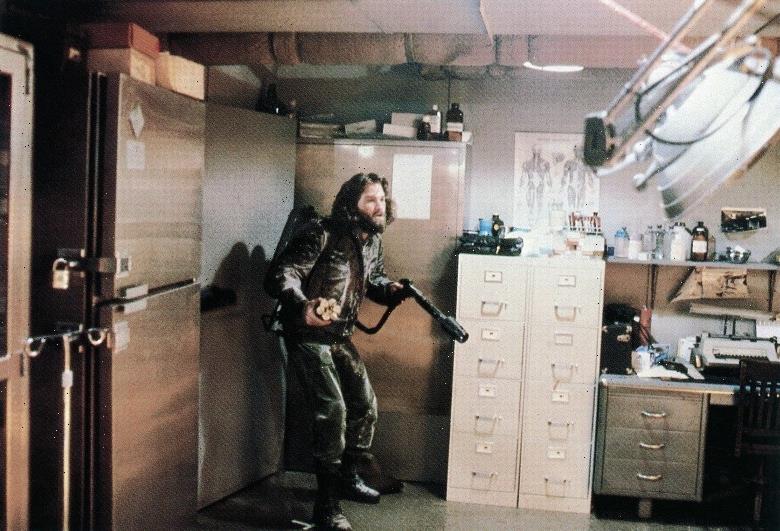Audiences came out in droves to see John Carpenter’s “The Thing” when it returned to theaters Sunday to mark its 40th anniversary, but many left the Fathom Events screenings disappointed: Many reported that the film was cropped from its original aspect ratio and the picture quality was bad. Fathom responded to the outcry with a fix. A second round of nationwide screenings on Wednesday will be in the film’s original widescreen format — which Carpenter considers a “happy ending.”
“It’s distressing, it’s horrible,” the director told IndieWire Tuesday, after several viral Twitter threads detailed the film’s subpar presentation. Among them was posts from director and podcast host Mick Garris, who vowed he would “never EVER” see a Fathom screening again, and encouraged his thousands of followers to do the same.
He said the film was shot in the 2.35:1 widescreen aspect ratio, but the version Fathom showed to some 730 theaters was 1.85:1 — meaning that one-third of the image was cut out (think back to the way some movies were cropped to fit square TVs before HDTV became commonplace).
This type of presentation incenses many filmmakers, but it’s a particularly sore spot for Carpenter. He’s long been a vocal proponent of widescreen formats and he made a point to shoot most of his movies in Panavision and in the 2.35:1 widescreen aspect ratio, which offers a broad canvas to stage complex shots with depth seen in classics like “Cool Hand Luke.”
“My visual collaborator was Dean Cundey, he and I had worked together before, this was the fourth time. I trust his lighting, it’s just gorgeous,” Carpenter said. “Widescreen is something I’ve done since the mid-’70s. I love widescreen, I’ve always loved it. Composing a movie in widescreen is tricky, but it’s beautiful.”
Producer Stuart Cohen told IndieWire “The Thing” was a passion project for him and that he fought to get it made and exhibited the way the director envisioned. The film’s critical reexamination, cult status, and return to theaters — after it was panned by critics and audiences alike in 1982 — should be a celebration, he said.
“It was always about the big screen, and the biggest screen imaginable and we fought for those privileges. We fought to get 70mm prints made for that purpose,” Cohen said. “It was particularly galling, after the film unceremoniously left theaters 40 years ago, that for its return to the big screen they played it in 1.85 — which John called a ‘bastard ratio,’ because you really couldn’t compose with it, because the sides were too wide and there was too much headroom.”
Carpenter, however, said he has accepted he has little say in how his work is presented after its original run. “I can’t control what they do on TV. I’ve learned over the years, in a sense, not to obsess over it. It makes life a lot easier,” he said.
Fathom released a statement to fans late Monday night after the outcry.
“Your patronage and trust are of utmost importance to us. We know you come to theaters expecting the very best experience possible and we pride ourselves in being the provider of that experience,” it reads. “We are aware that the recent showing of ‘The Thing’ wasn’t shown in its original aspect ratio and the disappointment it caused. Wednesday’s scheduled event will be shown in the proper aspect ratio, so you can see the film in theaters, as it was meant to be seen.”
In response to IndieWire’s questions, Fathom CEO Ray Nutt in a statement said the film will be delivered to theaters in 4K, and will be projected in either 2K or 4K, depending on the capabilities of a given auditorium’s projector. A 4K restoration of “The Thing” was released on Blu-ray last year and it premiered at the Aero Theatre in Santa Monica last month.
“I’m happy that people want ‘The Thing’ to be presented at a minimum — at a minimum, man — in the way we made it,” Carpenter said. “I’m delighted by that.”
The company in its initial statement didn’t address other quality issues of Sunday’s showing, which Garris described in a Tweet: “The picture was soft-focus, low-resolution, and the digital image was out of registration, so all objects were rimmed in red on one side, and blue on the other. Also, all movement all the way through the movie stuttered, like trying to watch Netflix with a really bad wifi signal.”
Sources say it comes down to the two very different distribution methods employed by Fathom. Some films are projected from DCPs, the industry standard digital cinema packages that offer high-quality sound and 2K or 4K resolution, but others beam into theaters via satellite and are recorded to a DVR, with standard HDTV-resolution pictures that are sometimes cropped.
Sources say that the quality difference is often noticeable: Sunday’s showings originated via satellite, Wednesday’s will be from DCPs. But Nutt described that satellite technology, referred to by Fathom as the Digital Broadcast Network, as a “powerful tool” that allows the company to broadcast both live and pre-recorded events.
“This was an isolated incident, and it is unfortunate that this incident is being confused with past events and tied to future events. The fact of the matter is, Fathom distributes a variety of content that ranges from those recently produced with the most state-of-the-art technology to 80-year-old classics. Given this range, the content dictates the delivery method which will vary for all future events,” he said.
The film’s distributor, Universal, has not returned requests for comment.
Source: Read Full Article
